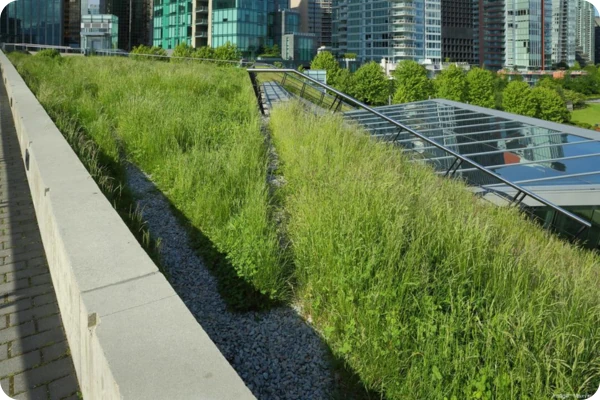As urban development continues to expand, cities face increasing challenges in managing stormwater runoff. Impervious surfaces like roads, rooftops, and sidewalks prevent water from naturally infiltrating the soil, leading to problems such as flooding, erosion, and water pollution. One innovative and sustainable solution gaining popularity is the installation of green roofs. These living systems provide numerous environmental benefits, particularly in stormwater management.

What Are Green Roofs?
Green roofs, also known as vegetated roofs or eco-roofs, consist of a layered system that includes a waterproof membrane, a drainage layer, a growing medium, and vegetation. They can be categorized into two main types:
- Extensive Green Roofs – Lightweight with a shallow soil depth (typically 2-6 inches), these roofs require minimal maintenance and support low-growing plants such as sedum and grasses.
- Intensive Green Roofs – Heavier and more complex, with deeper soil (6 inches or more), these roofs can support a wider range of vegetation, including shrubs and even small trees.
Both types contribute to improved stormwater management, but their effectiveness varies depending on factors such as climate, design, and plant selection.
How Green Roofs Help Manage Stormwater
1. Reducing Stormwater Runoff
Green roofs act as natural sponges, absorbing and retaining rainfall before slowly releasing it into the drainage system. Studies show that green roofs can retain 50-80% of annual rainfall, significantly reducing the volume of stormwater runoff and easing pressure on municipal drainage systems.
2. Delaying Peak Flow
During heavy rain events, stormwater systems can become overwhelmed, leading to urban flooding. Green roofs help by delaying peak runoff, allowing drainage infrastructure more time to manage excess water effectively.
3. Improving Water Quality
Traditional roofs collect pollutants such as dust, heavy metals, and chemicals, which are then washed into storm drains during rainfall. Green roofs filter out contaminants, improving the quality of runoff water before it reaches local waterways.
4. Enhancing Evapotranspiration
Plants on green roofs facilitate evapotranspiration, a natural process where moisture is absorbed and released back into the atmosphere. This reduces the overall volume of water entering storm drains while also helping to cool the surrounding environment.
Additional Benefits of Green Roofs
Beyond stormwater management, green roofs offer several other advantages, including:
- Energy Efficiency – They provide natural insulation, reducing heating and cooling costs for buildings.
- Urban Heat Island Mitigation – Green roofs lower surface temperatures, helping to combat the heat island effect in densely populated cities.
- Biodiversity Support – They create habitats for birds, insects, and other wildlife.
- Extended Roof Lifespan – The protective layers reduce wear and tear on the underlying roof structure, extending its durability.
Implementing Green Roofs for Stormwater Control
Property owners, developers, and municipalities can benefit from integrating green roofs into stormwater management plans. Many cities offer incentives, grants, or tax benefits to encourage green roof installations due to their environmental impact.
When considering a green roof, it’s important to evaluate factors such as load-bearing capacity, climate conditions, plant selection, and maintenance requirements. Working with experienced professionals ensures that the design and installation meet both sustainability and performance goals.
Challenges and Considerations for Green Roof Installation
While green roofs offer numerous benefits, implementing them successfully requires careful planning and consideration. Key factors include:
- Structural Integrity – Buildings must be able to support the additional weight of green roof systems, especially intensive designs.
- Drainage and Waterproofing – Proper drainage is essential to prevent water pooling and potential structural damage.
- Plant Selection – Choosing the right vegetation is crucial to ensure resilience to local climate conditions and low maintenance requirements.
- Maintenance Needs – Although extensive green roofs require less upkeep, periodic maintenance is necessary to ensure long-term performance and aesthetics.
Why Choose iSTORMWATER for Your Green Roof Project
At iSTORMWATER, we specialize in stormwater management solutions that enhance property value while ensuring compliance with local regulations. Our team can help assess, design, and maintain green roof systems that effectively control stormwater runoff and contribute to sustainable urban development. Contact us today or call us at (410) 231-3455 to learn how we can support your stormwater management goals and integrate green infrastructure into your property.
Real Results
iStormwater LLC was an excellent choice. They made the process of the Stormwater pond repairs seamless. They took charge of the project and got the project approved and passing the inspection. We highly recommend them and would use them again.
Incredible stormwater management service. The owner John consulted on a property I manage and ended up saving us thousands of dollars in environmental fees from the government. Now, our property is compliant with the EPA and we have a great partner to keep us maintained on stormwater regulations over time.
So helpful with all of my water issues.
Great communication and leadership and a family friendly atmosphere. Thank you John!
When it comes to stormwater management, Maryland sets a high bar. The state's program emphasizes protecting local waterways and the Chesapeake Bay through proactive design,...
- Annapolis
- Anne Arundel County
- Baltimore County
- Baltimore
- Bel Air South
- Bethesda
- Bowie
- Cecil County
- Charles County
- Columbia
- Gaithersburg
- Glen Burnie
- Howard County
- Montgomery County
- Pasadena
- Prince George’s County
- Rockville
- Severna Park
- St. Mary’s County



